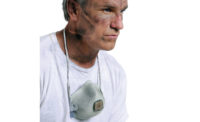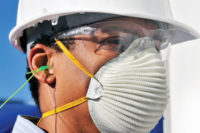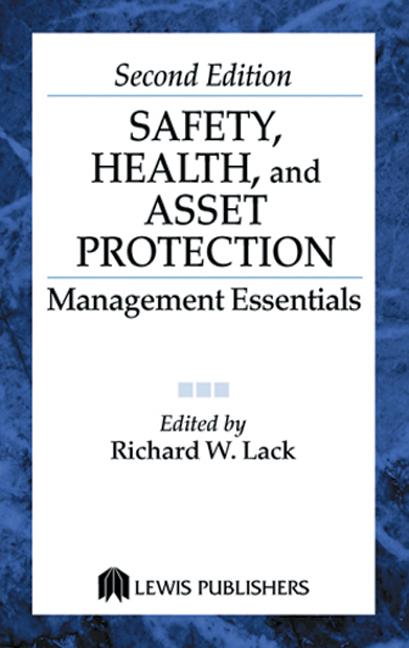Still other factors, such as chemical resistance of the materials making up the respirator, temperature of the environment in which the respirator is to be used, and how the respirator will be cleaned and serviced must be considered. Visibility, frequency and duration of use, and fit are also important considerations in the selection process. Of course, when respirators are required in the workplace all these, as well as other program elements, must all be incorporated into the written comprehensive respiratory protection program.
Overlooked usage factor
One factor, which is often overlooked, but relates critically to some of the other selection aspects noted above, is comfort. A respirator that is not comfortable is less likely to be worn through the duration of a job, where it is required. Comfort is affected by material selection, visibility, weight of the respirator, ease of use, as well as breathability. The question of duration and frequency of use must also be considered when evaluating the comfort factor.
Disregarding the employees’ input in selecting a comfortable respirator simply increases the likelihood of non-compliance with the respiratory protection program and increased likelihood that exposure will occur to the employee. A firm commitment by the employer to take into account the input of the employees will more likely ensure compliance.
Key factors that determine use
Factors that must be considered, and directly impact respirator comfort are: (1) material; (2) visibility; (3) weight; (4) amount of dead space; (5) type of strap or harness used and its ability to be properly adjusted; and (6) overall resistance, or breathability of the respirator when used. Taking each factor separately helps us understand the impact of each:
Different types of materials feel different to the skin.
When a respirator is in contact with the skin for extended periods of time, the feeling and softness of the material is an important factor. Nowadays, there are a multitude of materials that respirators are made from. Sometimes choice is dependent upon the chemical contaminant and the respirator’s resistance to the substance, but once the correct materials are chosen, it is important to involve the actual users to see which respirators are more comfortable to themVisibility is a safety issue, and a comfort issue.
The greater the visibility the employee has when wearing the respirator, the more comfortable they are and the less apprehensive they are about wearing the device. Lack of proper direct and peripheral vision tends to make people uncomfortable and usually will impede their ability to work efficiently. The less visibility they have, the more they must rely on their other senses to detect and perceive signals, including hazards in their work environment.
Weight is an important factor.
The heavier a respirator, the greater the fatigue to the user. Although, a few ounces difference may seem insignificant in the short term, it significantly adds to the fatigue factor when a respirator is worn for extended periods of time. The longer a respirator is worn, the more important it is that the respirator be light. Imagine a one-pound weight tied to your wrist. Although you would say that it is not a bother for a short period of time, it is likely that after a day your muscles would be noticeably fatigued.
Dead space is the amount of air that is found between the face-piece and the user’s face.
The less dead space in the respirator, the more comfortable the user. Dead space always contains residual amounts of exhaled carbon dioxide. The greater the dead space, the greater the carbon dioxide load. Carbon dioxide is an asphyxiant which affects circulation and breathing and can cause headache and drowsiness. The dead space displaces oxygen in the face-piece so that you must breathe deeper to obtain the requisite amount of oxygen for your work rate. Additionally, when carbon dioxide levels gets too high, this can cause a claustrophobic feeling.
How well the straps hold the respirator in place and the design of the strap both affect the overall comfort of a respirator.
For instance, given the same weight of a respirator, thinner straps tend to exert more force on the skin. Whether or not straps pull on hair and overall tension adjustability of the straps also both affect comfort significantly.
Resistance, or breathability, is an important factor.
Inhalation and exhalation of one’s breath requires the expenditure of energy, even without the use of a respiratory protection device. When wearing a respirator, the easier it is to inhale and exhale, the less fatigue that will be created over an extended period of time. In fact, one study showed that increased inhalation resistance was associated with decreased work performance. NIOSH requires that respirators meet inhalation and exhalation resistance criteria, but only sets a maximum. The lower the resistance, the better off the employee is and more likely that they will be willing to wear the respirator when required. Increased resistance can make the employee feel out of breath and claustrophobic.
All in all, there are many factors that employers must consider for their employees when choosing a respirator. Once the basic questions have been answered and the type of respirator is chosen i.e. filtration, level of protection (e.g. half-mask vs. full-face), material resistance, it is recommended that you obtain several designs that meet those criteria and then have the employees try on the respirators and see which one they prefer. Having employee “buy in” to the respirator program is critical and should never be overlooked.




